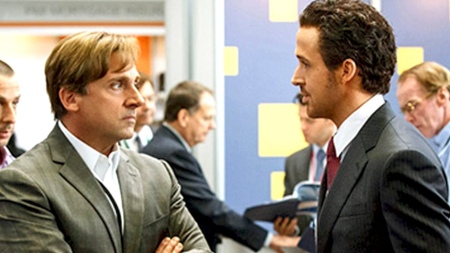
If you’ve got a hankering for Oscar-bait misery porn but your stomach rebels against the grue in The Revenant, you might want to know about Room. Those who haven’t read Emma Donoghue’s source novel (she’s also credited with the screenplay) may sit through the first few minutes in a state of alarm as the premise is set up: A young woman, Joy Newsome (Brie Larson), resides in a one-room shed along with her five-year-old son Jack (Jacob Tremblay); she has been held captive there for seven years, he since birth. So the viewer might exclaim, “Holy crap, are we going to be trapped in this room with Joy and Jack for the entire movie?” No; thankfully, we escape (along with them) slightly less than halfway through. In a further mercy, the film is chaste about showing us the nature of Joy’s relationship to her shaggy captor, known as Old Nick (Sean Bridgers). She is his sex slave, and he is Jack’s bio-dad, but we don’t have to look at the rapes or even hear much of it.
Is that a badge of honor, though? Room dabbles in tough stuff, but holds a lot of its details at a remove. It’s not really about the literal imprisonment anyway; it’s more about the mental incarceration Joy and Jack suffer once they have escaped Room. (Joy has built a whole world out of the tiny, shabby surroundings, and the shed is called Room, because to Jack it is Room, the only one.) The second half of the film, wherein mother and son try to adjust to life outside Room, verges on being interesting. But — perverse as it may seem to say so — it suffers in comparison to Tina Fey’s Netflix comedy The Unbreakable Kimmy Schmidt, which finds dark humor as well as genuine, hard-won insight in the similar premise of a recently freed captive woman. Room is too busy milking its situation for tears and tension to lower itself to anything so crass as levity. It’s serious, so very serious.
Larson is considered the favorite to take home Best Actress later this month, and I can’t begrudge her that. She takes a juicy part and squeezes it till it’s dry; the real protagonist, though, is Jack (the book was told through his eyes), and Tremblay makes him credibly damaged until the script calls for him to be a tribute to human resilience. There’s an unavoidable strain of snobbishness in the set-up: Old Nick is jobless and has trouble buying supplies for his prisoners, but once Joy and Jack get away from him and into the warm house of her well-to-do mom (Joan Allen) and her boyfriend, the moneyed milieu assures us that all will be well. Joy just needs a little more time to adjust, that’s all. But she’s also understandably lost a large chunk of her humanity during her seven-year captivity, something the movie doesn’t really have the resources to explore. All she needs, it turns out, is some of Jack’s hair.
The film sort of handwaves the fate of Old Nick; we don’t even see him arrested, though we assume he has been. This reticence to show revenge against aggressors (a trait it shares with The Revenant and Spotlight this Oscar season) establishes Room, I guess, as a drama that aspires to be deeper than the usual weepie. Meanwhile, we’re left with such questions as why Jack doesn’t react more strongly to a doctor who, like Old Nick, has a bushy dark beard, or why Jack goes in the yard to play with a boy we’ve never met, or what kind of nightmarishly overprotective parenting Jack can expect from Joy from now on. In Kimmy Schmidt, the bubbliness of Ellie Kemper’s brilliant performance always has a bleak, scary undertone that tells us her experience has made her different from everyone else. Kimmy’s chipper demeanor seems millimeters away from hysteria, and that’s the tension of the comedy. Joy and Jack, realistically, would not ever be okay again. Jack’s bidding farewell to the only world he knew for most of his short life should move us more, dig into our soft spots harder. Room isn’t a flatulent botch like Peter Jackson’s The Lovely Bones, but they coexist in the small subgenre of stories about a child’s suffering that probably should have stayed on the page.




